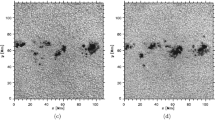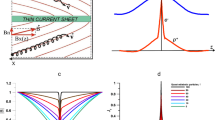Abstract
Earlier observational studies have used the time evolution of emerging magnetic flux regions at the photosphere to infer their subsurface structures, assuming that the flux structure does not change significantly over the near-surface layer. In this study, we test the validity of this assumption by comparing the horizontal and vertical motions of an emerging active region. The two motions would be correlated if the emerging structure is rigid. The selected active region (AR) NOAA 11645 is not embedded in detectable preexisting magnetic field. The observed horizontal motion is quantified by the separation of the two AR polarities and the width of the region. The vertical motion is derived from the magnetic buoyancy theory. Our results show that the separation of the polarities is fastest at the beginning with a velocity of \({\approx\,}4~\mbox{Mm}\,\mbox{hr}^{-1}\) and decreases to \({\le\,}1~\mbox{Mm}\,\mbox{hr}^{-1}\) after the main growing phase of flux emergence. The derived thick flux-tube buoyant velocity is between 1 and \(3~\mbox{Mm}\,\mbox{hr}^{-1}\), while the thin flux-tube approximation results in an unreasonably high buoyant velocity, consistent with the expectation that the approximation is inappropriate at the surface layer. The observed horizontal motion is not found to directly correlate with either the magnetic field strength or the derived buoyant velocities. However, the percentage of the horizontally oriented fields and the temporal derivatives of the field strength and the buoyant velocity show some positive correlations with the separation velocity. The results of this study imply that the assumption that the emerging active region is the cross section of a rising flux tube whose structure can be considered rigid as it rises through the near-surface layer should be taken with caution.















Similar content being viewed by others
References
Brandenburg, A., Kemel, K., Kleeorin, N., Mitra, D., Rogachevskii, I.: 2011, Detection of negative effective magnetic pressure instability in turbulence simulations. Astrophys. J. Lett. 740, L50. DOI . ADS .
Calabretta, M.R., Greisen, E.W.: 2002, Representations of celestial coordinates in FITS. Astron. Astrophys. 395, 1077. DOI . ADS .
Caligari, P., Moreno-Insertis, F., Schüssler, M.: 1995, Emerging flux tubes in the solar convection zone. 1: Asymmetry, tilt, and emergence latitude. Astrophys. J. 441, 886. DOI . ADS .
Centeno, R.: 2012, The naked emergence of solar active regions observed with SDO/HMI. Astrophys. J. 759, 72. DOI . ADS .
Cheung, M.C.M., Isobe, H.: 2014, Flux emergence (theory). Living Rev. Solar Phys. 11, 3. DOI . ADS .
Chintzoglou, G., Zhang, J.: 2013, Reconstructing the subsurface three-dimensional magnetic structure of a solar active region using SDO/HMI observations. Astrophys. J. Lett. 764, L3. DOI . ADS .
Chou, D.-Y.: 1993, Structure of emerging flux regions. In: Zirin, H., Ai, G., Wang, H. (eds.) IAU Colloq. 141: The Magnetic and Velocity Fields of Solar Active Regions, Astron. Soc. Pacific C. S. 46, 471. ADS .
Chou, D.-Y., Fisher, G.H.: 1989, Dynamics of anchored flux tubes in the convection zone. I – Details of the model. Astrophys. J. 341, 533. DOI . ADS .
Chou, D.-Y., Wang, H.: 1987, The separation velocity of emerging magnetic flux. Solar Phys. 110, 81. DOI . ADS .
Fan, Y.: 2004, Dynamics of emerging flux tubes. In: Sakurai, T., Sekii, T. (eds.) The Solar-B Mission and the Forefront of Solar Physics, Astron. Soc. Pacific C. S. 325, 47. ADS .
Fan, Y.: 2008, The three-dimensional evolution of buoyant magnetic flux tubes in a model solar convective envelope. Astrophys. J. 676, 680. DOI . ADS .
Harvey, K.L., Martin, S.F.: 1973, Ephemeral active regions. Solar Phys. 32, 389. DOI . ADS .
Hoeksema, J.T., Liu, Y., Hayashi, K., Sun, X., Schou, J., Couvidat, S., Norton, A., Bobra, M., Centeno, R., Leka, K.D., Barnes, G., Turmon, M.: 2014, The Helioseismic and Magnetic Imager (HMI) vector magnetic field pipeline: Overview and performance. Solar Phys. 289, 3483. DOI . ADS .
Kubo, M., Shimizu, T., Lites, B.W.: 2003, The evolution of vector magnetic fields in an emerging flux region. Astrophys. J. 595, 465. DOI . ADS .
Leka, K.D., Canfield, R.C., McClymont, A.N., van Driel-Gesztelyi, L.: 1996, Evidence for current-carrying emerging flux. Astrophys. J. 462, 547. DOI . ADS .
Lites, B.W., Skumanich, A., Martinez Pillet, V.: 1998, Vector magnetic fields of emerging solar flux. I. Properties at the site of emergence. Astron. Astrophys. 333, 1053. ADS .
Metcalf, T.R.: 1994, Resolving the 180-degree ambiguity in vector magnetic field measurements: The ‘minimum’ energy solution. Solar Phys. 155, 235. DOI . ADS .
Parker, E.N.: 1955, The formation of sunspots from the solar toroidal field. Astrophys. J. 121, 491. DOI . ADS .
Parker, E.N.: 1978, Hydraulic concentration of magnetic fields in the solar photosphere. VI – Adiabatic cooling and concentration in downdrafts. Astrophys. J. 221, 368. DOI . ADS .
Pesnell, W.D., Thompson, B.J., Chamberlin, P.C.: 2012, The Solar Dynamics Observatory (SDO). Solar Phys. 275, 3. DOI . ADS .
Rempel, M.: 2011, Subsurface magnetic field and flow structure of simulated sunspots. Astrophys. J. 740, 15. DOI . ADS .
Rempel, M., Cheung, M.C.M.: 2014, Numerical simulations of active region scale flux emergence: From spot formation to decay. Astrophys. J. 785, 90. DOI . ADS .
Schou, J., Scherrer, P.H., Bush, R.I., Wachter, R., Couvidat, S., Rabello-Soares, M.C., Bogart, R.S., Hoeksema, J.T., Liu, Y., Duvall, T.L., Akin, D.J., Allard, B.A., Miles, J.W., Rairden, R., Shine, R.A., Tarbell, T.D., Title, A.M., Wolfson, C.J., Elmore, D.F., Norton, A.A., Tomczyk, S.: 2012, Design and ground calibration of the Helioseismic and Magnetic Imager (HMI) instrument on the Solar Dynamics Observatory (SDO). Solar Phys. 275, 229. DOI . ADS .
Schüssler, M.: 1979, Magnetic buoyancy revisited – Analytical and numerical results for rising flux tubes. Astron. Astrophys. 71, 79. ADS .
Shimizu, T., Shine, R.A., Title, A.M., Tarbell, T.D., Frank, Z.: 2002, Photospheric magnetic activities responsible for soft X-ray pointlike microflares. I. Identifications of associated photospheric/chromospheric activities. Astrophys. J. 574, 1074. DOI . ADS .
Strous, L.H., Scharmer, G., Tarbell, T.D., Title, A.M., Zwaan, C.: 1996, Phenomena in an emerging active region. I. Horizontal dynamics. Astron. Astrophys. 306, 947. ADS .
Sun, X.: 2013, On the coordinate System of Space-Weather HMI Active Region Patches (SHARPs): A technical note. ArXiv e-prints. arXiv .
Tanaka, K.: 1991, Studies on a very flare-active delta group – Peculiar delta spot evolution and inferred subsurface magnetic rope structure. Solar Phys. 136, 133. DOI . ADS .
Weber, M.A., Fan, Y., Miesch, M.S.: 2011, The rise of active region flux tubes in the turbulent solar convective envelope. Astrophys. J. 741, 11. DOI . ADS .
Acknowledgements
This work is funded by the MOST of ROC under grant NSC 102-2112-M-008-018 and the MOE grant “Aim for the Top University” to the National Central University.
Author information
Authors and Affiliations
Corresponding author
Ethics declarations
Disclosure of Potential Conflicts of Interest
The authors declare that they have no conflicts of interest.
Rights and permissions
About this article
Cite this article
Lin, CH., Chen, YC. Examining the Magnetic Field Strength and the Horizontal and Vertical Motions in an Emerging Active Region. Sol Phys 291, 751–777 (2016). https://doi.org/10.1007/s11207-016-0876-3
Received:
Accepted:
Published:
Issue Date:
DOI: https://doi.org/10.1007/s11207-016-0876-3




